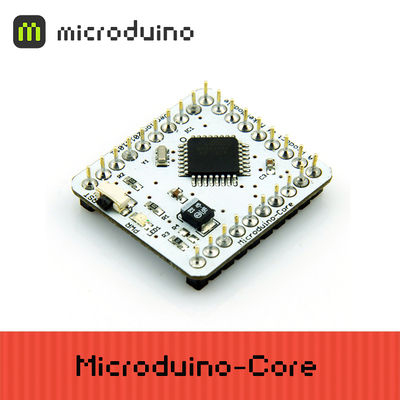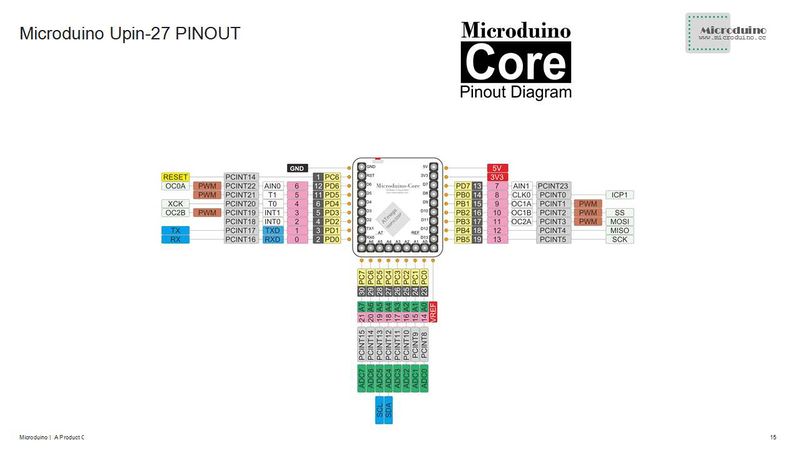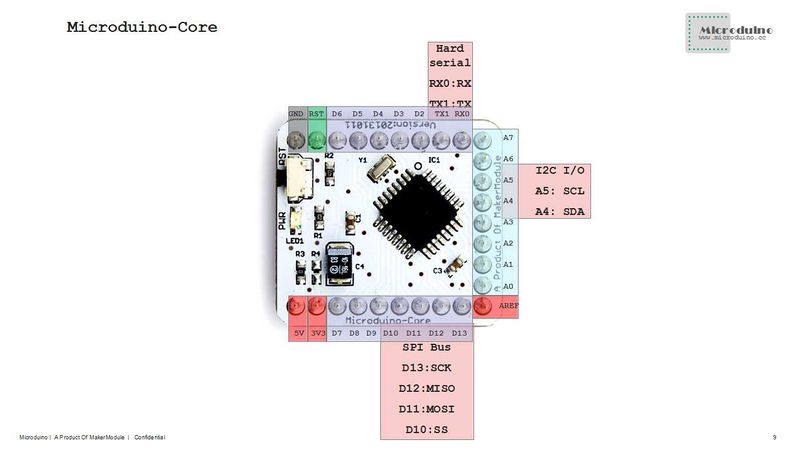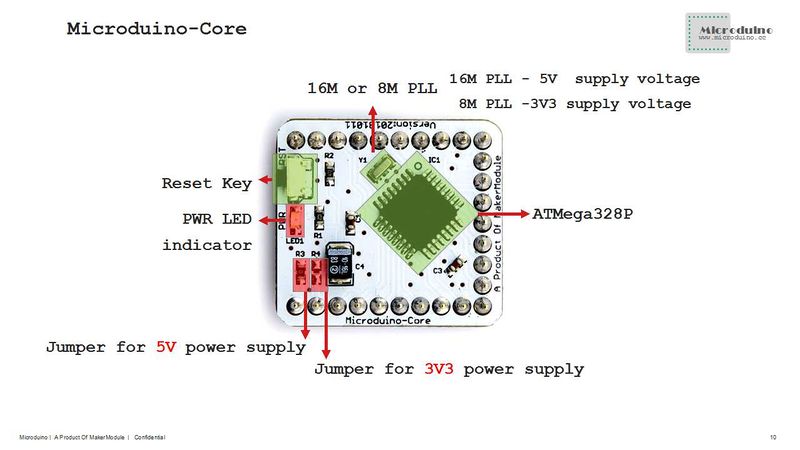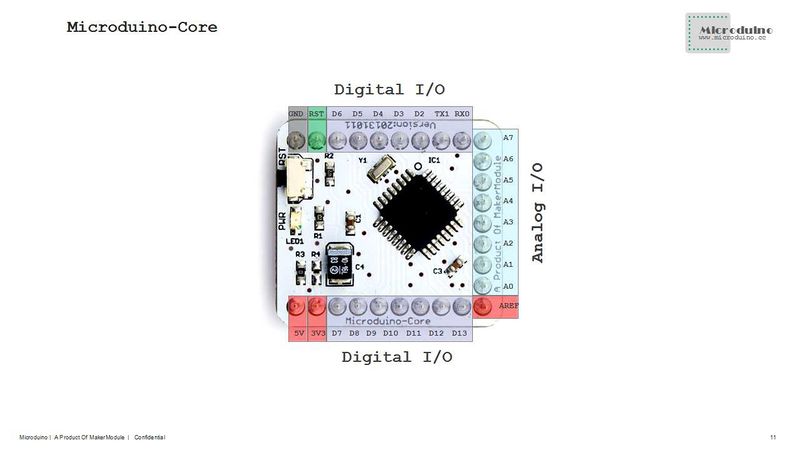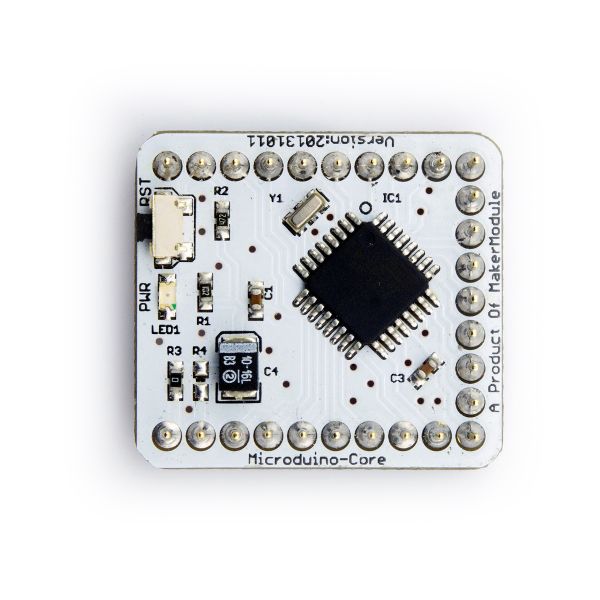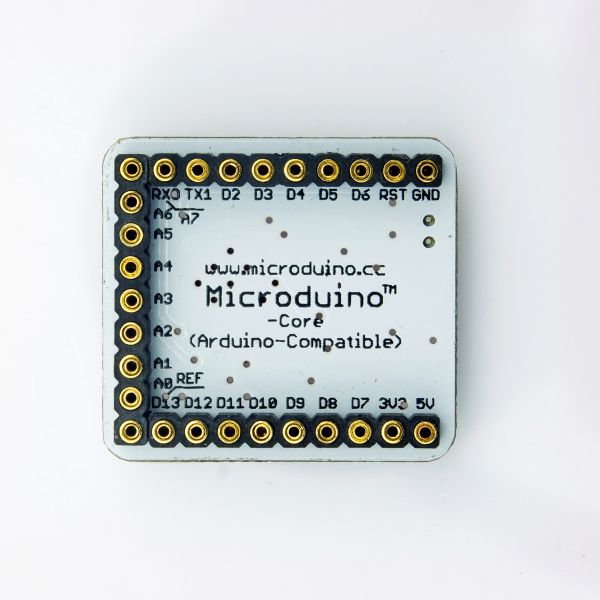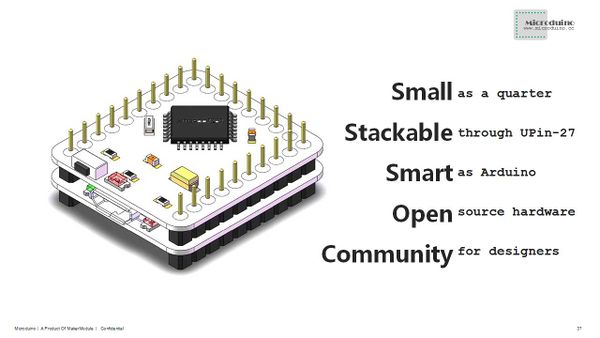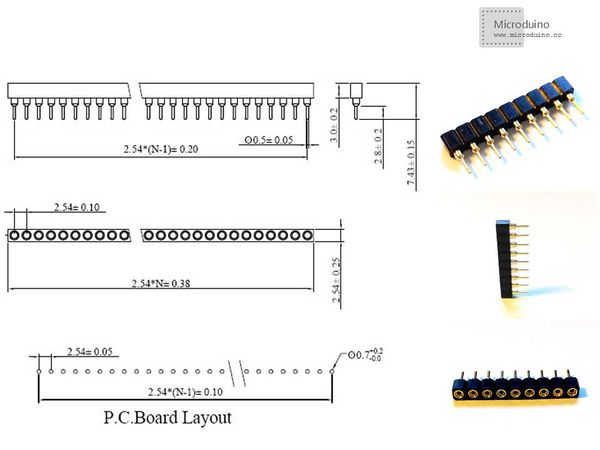“Microduino-Core”的版本间的差异
Makermodule(讨论 | 贡献) |
714982818@qq.com(讨论 | 贡献) |
||
| (未显示6个用户的20个中间版本) | |||
| 第1行: | 第1行: | ||
| + | {{Language|Microduino-Core}} | ||
{| style="width: 800px;" | {| style="width: 800px;" | ||
|- | |- | ||
| | | | ||
| − | [[file:Microduino-core-rect.jpg|400px|thumb|right|Microduino-Core]] | + | [[file:Microduino-core -rect.jpg|400px|thumb|right|Microduino-Core]] |
| − | '''[[Microduino-Core]]''' is one of core modules of Microduino series, '''[[Microduino-Core]]''' | + | '''[[Microduino-Core]]''' is one of core modules of Microduino series, '''[[Microduino-Core]]''' is an open source hardware and Arduino Uno compatible. It is an 8-bit microcontroller development board, based on Atmel ATmega328P/ATmega168PA series. |
| − | |||
| − | is an open source hardware and Arduino Uno compatible. It is an 8-bit microcontroller development | ||
| − | |||
| − | board, based on Atmel ATmega328P/ATmega168PA series. | ||
Comparing to Arduino Uno, '''[[Microduino-Core]]''' is featured by: | Comparing to Arduino Uno, '''[[Microduino-Core]]''' is featured by: | ||
| − | * Microduino splits '''[http://arduino.cc/en/Main/ArduinoBoardUno Arduino Uno]''' into two parts: | + | * Microduino splits '''[http://arduino.cc/en/Main/ArduinoBoardUno Arduino Uno]''' into two parts: '''[[Microduino-Core]]''' and '''[[Microduino-FT232R]]''' modules -- MCU and USB2TTL parts. it means once designers uploaded program into '''[[Microduino-Core]]''', '''[[Microduino-FT232R]]''' will be not necessary anymore, designers could have many Microduino-Core/Core+ modules with only one '''[[Microduino-FT232R]]'''. The board size becomes very small as only 25.4mm X 27.94mm (1.0inch X 1.1inch), like a quarter. |
| − | + | * Microduino series uses the U-Shape 27-pin interface (UPin-27), the standard interface of Microduino, all Microduino modules and sensors can be easily stacked and extended, it is delivered ready to plug in. | |
| − | '''[[Microduino-Core]]''' and '''[[Microduino-FT232R]]''' modules -- MCU and USB2TTL parts. it | + | * With tiny shape and uniform interface, Microduino series dramatically decreases the size and cost of design prototype, remarkable improves usability and flexibility of Arduino-compatible boards, as well as user experience. |
| − | |||
| − | means once designers uploaded program into '''[[Microduino-Core]]''', '''[[Microduino-FT232R]]''' | ||
| − | |||
| − | will be not necessary anymore, designers could have many Microduino-Core/Core+ modules with only | ||
| − | |||
| − | one '''[[Microduino-FT232R]]'''. The board size becomes very small as only 25.4mm X 27.94mm | ||
| − | |||
| − | (1.0inch X 1.1inch), like a quarter. | ||
| − | * Microduino series uses the U-Shape 27-pin interface (UPin-27), the standard interface of | ||
| − | |||
| − | Microduino, all Microduino modules and sensors can be easily stacked and extended, it is delivered | ||
| − | |||
| − | ready to plug in. | ||
| − | * With tiny shape and uniform interface, Microduino series dramatically decreases the size and | ||
| − | |||
| − | cost of design prototype, remarkable improves usability and flexibility of Arduino-compatible | ||
| − | + | Microduino uses the same development environment as Arduino IDE, designers can use the Arduino IDE, Processing on Microduino for idea realization, prototype development and low volume production. | |
| − | + | Microduino uses optiboot for bootloader, it takes less Flash than Arduino default engine and optimizes program uploading. | |
| − | |||
| − | |||
| − | |||
| − | |||
| − | |||
| − | |||
| − | Microduino uses optiboot for bootloader, it takes less Flash than Arduino default engine and | ||
| − | |||
| − | optimizes program uploading. | ||
Currently, there are 4 different configurations for '''[[Microduino-Core]]''' modules: | Currently, there are 4 different configurations for '''[[Microduino-Core]]''' modules: | ||
| 第82行: | 第54行: | ||
|} | |} | ||
Different configurations in frequency and supply voltage: | Different configurations in frequency and supply voltage: | ||
| − | * Clock frequency and supply voltage are paired, 8M module is supplied by 3.3V voltage, while 16M | + | * Clock frequency and supply voltage are paired, 8M module is supplied by 3.3V voltage, while 16M module is by 5.0V voltage. |
| − | + | * A 16M with 5V '''[[Microduino-Core]]''' module is recommended for desktop equipments or designs; regarding mobile equipments or designs, a 8M with 3.3V module is suggested for low power and battery supply purposes. | |
| − | module is by 5.0V voltage. | ||
| − | * A 16M with 5V '''[[Microduino-Core]]''' module is recommended for desktop equipments or designs; | ||
| − | |||
| − | regarding mobile equipments or designs, a 8M with 3.3V module is suggested for low power and | ||
| − | |||
| − | battery supply purposes. | ||
| 第96行: | 第62行: | ||
| | | | ||
==Core vs Core+== | ==Core vs Core+== | ||
| − | * Microduino also provides '''[[Microduino-Core+]]''' module, aiming at high performance | + | * Microduino also provides '''[[Microduino-Core+]]''' module, aiming at high performance applications which require large SRAM/EEPROM/Flash and more I/O ports. |
| − | + | * Both '''[[Microduino-Core]]''' and '''[[Microduino-Core+]]''' use UPin-27 interface -- the standard module interface of Microduino series. The main difference between them is MCU chip: -Core module uses ATmega328P/ATmega168PA, as same as Arduino Uno; -Core+ module uses ATmega644PA/ATmega1284P, its performance is similar to Arduino Mega2560. | |
| − | |||
| − | * Both '''[[Microduino-Core]]''' and '''[[Microduino-Core+]]''' use UPin-27 interface -- the | ||
| − | |||
| − | standard module interface of Microduino series. The main difference between them is MCU chip: - | ||
| − | |||
| − | Core module uses ATmega328P/ATmega168PA, as same as Arduino Uno; -Core+ module uses | ||
| − | |||
| − | ATmega644PA/ATmega1284P, its performance is similar to Arduino Mega2560. | ||
* Configuration difference between '''[[Microduino-Core]]''' and '''[[Microduino-Core+]]''' | * Configuration difference between '''[[Microduino-Core]]''' and '''[[Microduino-Core+]]''' | ||
| 第159行: | 第117行: | ||
|} | |} | ||
| − | * According above table, Core and Core+ are different in Flash, EEPROM and SRAM size, also, they | + | * According above table, Core and Core+ are different in Flash, EEPROM and SRAM size, also, they supply different size of digital I/O and hardware serial ports, and there are 10 more digital I/O and 1 more hardware serial ports in Core+. Designers can select specific module regarding different application requirements on function, performance and power. |
| − | |||
| − | supply different size of digital I/O and hardware serial ports, and there are 10 more digital I/O | ||
| − | |||
| − | and 1 more hardware serial ports in Core+. Designers can select specific module regarding | ||
| − | |||
| − | different application requirements on function, performance and power. | ||
| − | |||
| − | |||
| − | them. | + | * Both Core and Core+ use UPin-27 interface, Microduino program can be smoothly ported between them. |
|- | |- | ||
| 第189行: | 第139行: | ||
* Microcontroller: ATmega328P/ATmega168PA | * Microcontroller: ATmega328P/ATmega168PA | ||
* Operating Voltage: 5V/3.3V | * Operating Voltage: 5V/3.3V | ||
| − | |||
* Digital I/O Pins: 14 (of which 6 provide PWM output with D3,D5,D6,D9,D10 and D11) | * Digital I/O Pins: 14 (of which 6 provide PWM output with D3,D5,D6,D9,D10 and D11) | ||
* Analog Input Pins: 8 (2 more comparing to Arduino Uno) | * Analog Input Pins: 8 (2 more comparing to Arduino Uno) | ||
| 第195行: | 第144行: | ||
* DC Current: 50 mA | * DC Current: 50 mA | ||
* Serial: 0 (RX) and 1 (TX). Used to receive (RX) and transmit (TX) TTL serial data. | * Serial: 0 (RX) and 1 (TX). Used to receive (RX) and transmit (TX) TTL serial data. | ||
| − | * External Interrupts: 2 and 3. These pins can be configured to trigger an interrupt on a low | + | * External Interrupts: 2 and 3. These pins can be configured to trigger an interrupt on a low value, a rising or falling edge, or a change in value. See the attachInterrupt() function for details. |
| − | |||
| − | value, a rising or falling edge, or a change in value. See the attachInterrupt() function for | ||
| − | |||
| − | details. | ||
* PWM: 3, 5, 6, 9, 10, and 11. Provide 8-bit PWM output with the analogWrite() function. | * PWM: 3, 5, 6, 9, 10, and 11. Provide 8-bit PWM output with the analogWrite() function. | ||
* SPI: 10 (SS), 11 (MOSI), 12 (MISO), 13 (SCK). These pins support SPI communication using the SPI | * SPI: 10 (SS), 11 (MOSI), 12 (MISO), 13 (SCK). These pins support SPI communication using the SPI | ||
| 第249行: | 第194行: | ||
|} | |} | ||
| − | :[[file:Microduino-Core- | + | :[[file:Microduino-Core-Pinout.jpg|800px|thumb|center|Microduino-Core-Pinout]] |
| − | :[[file:Microduino-Core- | + | :[[file:Microduino-Core-Pinout1.jpg|800px|thumb|center|Microduino-Core-Pinout]] |
| − | :[[file:Microduino-Core- | + | :[[file:Microduino-Core-Pinout2.jpg|800px|thumb|center|Microduino-Core-Pinout]] |
| − | :[[file:Microduino-Core- | + | :[[file:Microduino-Core-Pinout3.jpg|800px|thumb|center|Microduino-Core-Pinout]] |
| − | |||
| − | |||
| − | |||
|- | |- | ||
| 第262行: | 第204行: | ||
==Documents== | ==Documents== | ||
| − | |||
| − | |||
| − | |||
| − | |||
| − | |||
| − | |||
* '''[[Microduino-Core]]''' Eagle source file 【'''[[media:Microduino-Core.zip|download]]'''】 | * '''[[Microduino-Core]]''' Eagle source file 【'''[[media:Microduino-Core.zip|download]]'''】 | ||
* '''[[Microduino-Core]]''' main chips and devices | * '''[[Microduino-Core]]''' main chips and devices | ||
** MCU: '''[[media:ATmega168PA328P.pdf|ATmega168PA/328P]]''' | ** MCU: '''[[media:ATmega168PA328P.pdf|ATmega168PA/328P]]''' | ||
| − | |||
| − | |||
|- | |- | ||
| | | | ||
==Development== | ==Development== | ||
| − | + | '''[[Microduino Getting start]]''' | |
| − | |||
| − | |||
| − | |||
| − | |||
| − | |||
| − | |||
| − | |||
| − | |||
| − | |||
| − | |||
| − | |||
| − | |||
| − | |||
| − | |||
| − | |||
| − | |||
| − | |||
| − | |||
| − | |||
* Burn Microduino BootLoader | * Burn Microduino BootLoader | ||
| − | ** Bootloader burning is necessary if designers want to update Microduino-Core/Core+ firmware by | + | ** Bootloader burning is necessary if designers want to update Microduino-Core/Core+ firmware by themselves, designers can leaverage Arduino Uno or another burned Microduino-Core/Core+ to make a new one. |
| − | + | ** Microduino bootloader workshop: 【'''[[Burn Bootloader to Microduino-Core/Core+ with an Arduino]]'''】. | |
| − | themselves, designers can leaverage Arduino Uno or another burned Microduino-Core/Core+ to make a | + | ** Bootloader is specified for different Microduino-Core/Core+ configurations, correct one must be selected during burning. |
| − | + | ** Initial bootloader is designed for ATmegaX8 series optiboot, which occupies only 512 bytes flash. | |
| − | new one. | + | * How to download program to Microduino through Arduino:'''[[Media:Arduino-Miccroduino-e.pdf|Download program to Microduino through Arduino ]]''' |
| − | ** Microduino bootloader workshop: 【'''[[Burn Bootloader to Microduino-Core/Core+ with an | ||
| − | |||
| − | Arduino]]'''】. | ||
| − | ** Bootloader is specified for different Microduino-Core/Core+ configurations, correct one must be | ||
| − | |||
| − | selected during burning. | ||
| − | ** Initial bootloader is designed for ATmegaX8 series optiboot, which occupies only 512 bytes | ||
| − | |||
| − | |||
|- | |- | ||
| | | | ||
| 第324行: | 第230行: | ||
|- | |- | ||
| | | | ||
| + | |||
| + | ==FAQ== | ||
| + | *How to use the Microduino? | ||
| + | **Install Arduino IDE | ||
| + | **Download Arduino IDE Microduino hardware support package:https://github.com/wasdpkj/Microduino-IDE/tree/master/arduino-1.0.6-windows/hardware/Microduino | ||
| + | **Write the code in Arduino IDE,recommend use release 1.0 or upper | ||
| + | **Connect the hardware,core/core+ and USBTTL module, select the correct board type and download the program | ||
| + | **If download failed, please check the hardware connection firstly, and then reset the board, try again | ||
| + | **If still failure, you can search the failure information in internet, maybe need burn the bootloader. How to burn the bootloader, please refer to following link:【'''[[Burn Bootloader to Microduino-Core/Core+ with an Arduino]]'''】 | ||
| + | *Do you have 3.3V version board? | ||
| + | **So far no. | ||
| + | *Does Core has PWM pin? | ||
| + | **Core supports six PWM output, that is I/O port 3,5,6,9,10 and 11. Core+ supports six PWM output, that is 7,8,9,10,22 and 23 | ||
==Buy== | ==Buy== | ||
| − | * Buy '''[http://www. | + | * Buy '''[http://www.microduino.cc/Modules/Microdoino%20Core%20Modules/Microdoino-Core Microduino-Core]''' |
|- | |- | ||
| 第338行: | 第257行: | ||
| | | | ||
==Pictures== | ==Pictures== | ||
| − | :[[file:Microduino-Core- | + | :[[file:Microduino-Core-t.JPG|thumb|600px|center|Microduino-core Front]] |
| + | <br style="clear: left"/> | ||
| + | :[[file:Microduino-Core-b.JPG|thumb|600px|center|Microduino-core Back]] | ||
<br style="clear: left"/> | <br style="clear: left"/> | ||
| − | :[[file:Microduino-Core- | + | :[[file:Microduino-Core-3d.jpg|thumb|600px|center|Microduino-core 3D model]] |
<br style="clear: left"/> | <br style="clear: left"/> | ||
| − | :[[file:Microduino-Core- | + | :[[file:Microduino-Core-Upin27.jpg|thumb|600px|center|Microduino-core Upin27 model]] |
<br style="clear: left"/> | <br style="clear: left"/> | ||
|} | |} | ||
2014年12月5日 (五) 08:58的最新版本
| Language | English |
|---|
|
Microduino-Core is one of core modules of Microduino series, Microduino-Core is an open source hardware and Arduino Uno compatible. It is an 8-bit microcontroller development board, based on Atmel ATmega328P/ATmega168PA series. Comparing to Arduino Uno, Microduino-Core is featured by:
Microduino uses the same development environment as Arduino IDE, designers can use the Arduino IDE, Processing on Microduino for idea realization, prototype development and low volume production. Microduino uses optiboot for bootloader, it takes less Flash than Arduino default engine and optimizes program uploading. Currently, there are 4 different configurations for Microduino-Core modules:
Different configurations in frequency and supply voltage:
| |||||||||||||||||||||||||||||||||||||||||||
目录Core vs Core+
| |||||||||||||||||||||||||||||||||||||||||||
Features
Microduino modules and sensors can be easily stacked and extended through it
| |||||||||||||||||||||||||||||||||||||||||||
Specifications
library.
| |||||||||||||||||||||||||||||||||||||||||||
Documents
| |||||||||||||||||||||||||||||||||||||||||||
Development
| |||||||||||||||||||||||||||||||||||||||||||
Applications
| |||||||||||||||||||||||||||||||||||||||||||
FAQ
Buy
| |||||||||||||||||||||||||||||||||||||||||||
History
| |||||||||||||||||||||||||||||||||||||||||||
Pictures
|
